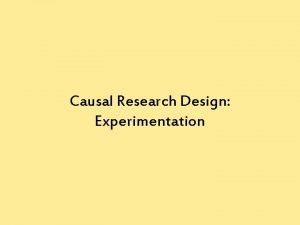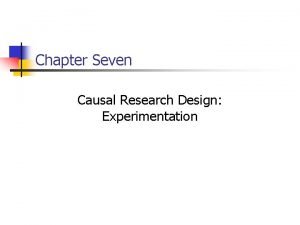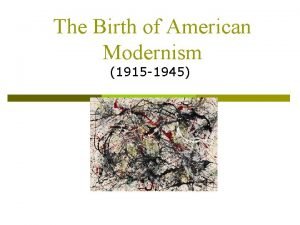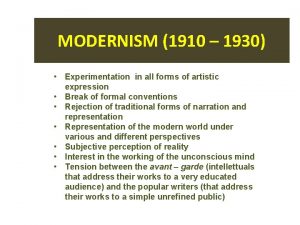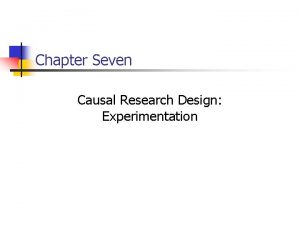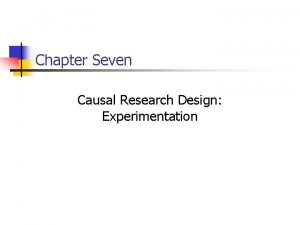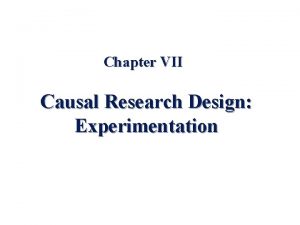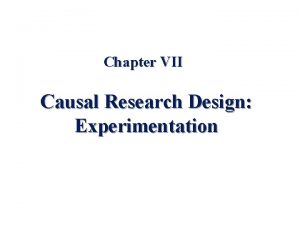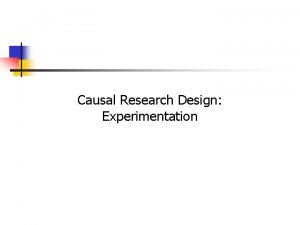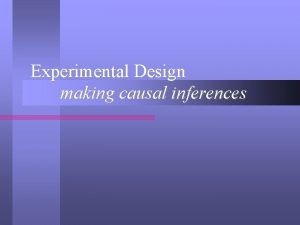Chapter Seven Causal Research Design Experimentation Copyright 2010











- Slides: 11

Chapter Seven Causal Research Design: Experimentation Copyright © 2010 Pearson Education, Inc. publishing as Prentice Hall 7 -1

Concept of Causality A statement such as "X causes Y" will have the following meaning to an ordinary person and to a scientist. __________________________ Ordinary Meaning Scientific Meaning __________________________ X is the only cause of Y. X is only one of a number of possible causes of Y. X must always lead to Y (X is a deterministic cause of Y). The occurrence of X makes the occurrence of Y more probable (X is a probabilistic cause of Y). It is possible to prove that X is a cause of Y. We can never prove that X is a cause of Y. At best, we can infer that X is a cause of Y. Copyright © 2010 Pearson Education, Inc. publishing as Prentice Hall 7 -2

Conditions for Causality • Concomitant variation is the extent to which a cause, X, and an effect, Y, occur together or vary together in the way predicted by the hypothesis under consideration. Thus, we may hypothesize that increasing product price will lead to an increase in profits. • The time order of occurrence condition states that the causing event must occur either before or simultaneously with the effect; it cannot occur afterwards. Thus, our profits cannot increase until after we increase the price. Copyright © 2010 Pearson Education, Inc. publishing as Prentice Hall 7 -3

Conditions for Causality • The absence of other possible causal factors means that the factor or variable being investigated should be the only possible causal explanation. Thus, other factors like store penetration, expanded consumer spending, or decreased costs must be held constant. Copyright © 2010 Pearson Education, Inc. publishing as Prentice Hall 7 -4

Definitions and Concepts Independent variables are variables or alternatives that are manipulated and whose effects are measured and compared, e. g. , price levels. Such as price levels, different package designs, and advertising themes. Test units are individuals, organizations, or other entities whose response to the independent variables or treatments is being examined, e. g. , consumers or stores. Such as consumers, stores, and geographic areas. Copyright © 2010 Pearson Education, Inc. publishing as Prentice Hall 7 -5

Definitions and Concepts • Dependent variables are the variables which measure the effect of the independent variables on the test units, e. g. , sales, profits, and market shares. Such as sales, profits, and market shares. • Extraneous variables are all variables other than the independent variables that affect the response of the test units, e. g. , store size, store location, and competitive effort. Such as store size, store location, and competitive effort. Copyright © 2010 Pearson Education, Inc. publishing as Prentice Hall 7 -6

Experimental Design An experimental design is a set of procedures specifying: n n the test units and how these units are to be divided into homogeneous subsamples, what independent variables or treatments are to be manipulated, n what dependent variables are to be measured; and n how the extraneous variables are to be controlled. Copyright © 2010 Pearson Education, Inc. publishing as Prentice Hall 7 -7

Validity in Experimentation • Internal validity refers to whether the manipulation of the independent variables or treatments actually caused the observed effects on the dependent variables. Control of extraneous variables is a necessary condition for establishing internal validity. For example, if we hypothesize that selling through national chains will increase profits, we must hold all other causes of increased profits constant in order to conclude internal validity. Copyright © 2010 Pearson Education, Inc. publishing as Prentice Hall 7 -8

Validity in Experimentation • External validity refers to whether the cause-and -effect relationships found in the experiment can be generalized. To what populations, settings, times, independent variables, and dependent variables can the results be projected? • External validity can be seen in a study that randomly selects stores from all markets in which a national chain operates. Assuming that the study takes into account all realistic factors, any findings that hold for all these markets will generalize to all stores in the national chain. Copyright © 2010 Pearson Education, Inc. publishing as Prentice Hall 7 -9

Criteria for the Selection of Test Markets • In a standard test market the product is sold through regular distribution channels. The company’s own sales force is responsible for distributing the product, stocking the shelves, and taking inventory at regular intervals. • A controlled test marketing program is conducted by an outside research company. The research company is responsible for all activities associated with the test market. • Simulated test markets yield mathematical estimates of market share based on initial reaction of the consumers to the new product. Copyright © 2010 Pearson Education, Inc. publishing as Prentice Hall 7 -10

All rights reserved. No part of this publication may be reproduced, stored in a retrieval system, or transmitted, in any form or by any means, electronic, mechanical, photocopying, recording, or otherwise, without the prior written permission of the publisher. Printed in the United States of America. Copyright © 2010 Pearson Education, Inc. publishing as Prentice Hall 7 -11
 Different types of saes
Different types of saes Correlational vs comparative
Correlational vs comparative Casual research example
Casual research example Causal research design
Causal research design Characteristics of conclusive research
Characteristics of conclusive research Research design for exploratory research
Research design for exploratory research Research design
Research design Modernism and experimentation in american literature
Modernism and experimentation in american literature Active experimentation
Active experimentation Modernism and experimentation
Modernism and experimentation Experimentation in modernism
Experimentation in modernism R x o research design
R x o research design


